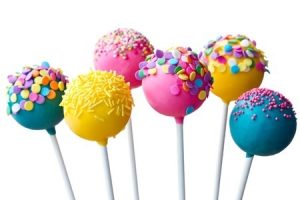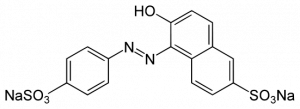Sunset Yellow FCF (E110) which is also known as Orange Yellow S, or C.I. 15985 has been a food colour of long standing in all sorts of foods and cosmetics including hair colourings and skin creams. It is especially valued in soft drinks where natural colours fade readily especially at high temperature storage in tropical regions. It is also often found in confectionary such as jellies, cake fillings, marzipan and candies, snacks, sauces and preserved fruits (Abbey et al., 2013).
Manufacture
Sunset yellow is a synthetic azo dye called disodium 2-hydroxy-1-(4-sulfonatophenylazo)naphthalene-6-sulfonate and produced from petroleum which produces a vibrant yellow-orange. Sunset Yellow FCF is manufactured by diazotizing 4-aminobenzenesulphonic acid using hydrochloric acid and sodium nitrite or sulphuric acid and sodium nitrite. The diazo compound is coupled with 6-hydroxy-2-naphthalene-sulphonic acid. It has a pH dependent maximum absorption close to 480 nm (pH 1) and at 443nm (pH 13) with a shoulder at 500 nm (Abbey et al., 2013). Calcium and potassium variants are permitted.
Current Regulations For Sunset Yellow In The EU
The addition of Sunset Yellow FCF is strictly controlled by food laws and regulations throughout the world but it is banned in Norway, Sweden and Finland because of safety concerns. In the European Community, the colour is currently authorised according to Directive 954/36/EC and is treated as an additive because it is synthetic according to Commission Regulation 1333/2008 (see Annex no. 5) and given the E number E110. It must also carry the warning on the label ‘may have an adverse effect on activity and attention in children’. Since then, purity specifications have been established for all additives according to Commission Regulation No. 231/2012 including this ingredient.

Changes To The ADI
The EU Standing Committee on the Food Chain and Animal Health have looked at Sunset Yellow levels over a number of years. They initially reduced the levels of this colour in flavoured drinks following a review of its safety in 2009 by EFSA (European Food Safety Authority) using their ‘Panel on Food Additives and Nutrient Sources added to Food’ (ANS Panel) who were responding to new maximum permitted levels and also adopting a precautionary approach.
Before 2009, the original maximum permitted level had been 50mg/litre in drinks. There had been concerns on the level of this added artificial colour being ingested along with others. They identified children as the most susceptible group to exposure because of the high intake from beverages and it was felt a requirement for further safety evaluation be conducted on these exposure levels. The maximum permitted level as a food additive then dropped in 2009 to 20 mg/litre in ready to drink flavoured products, down from the previous level of 50 mg/litre. This readjustment occurred following the change in the Acceptable Daily Intake (ADI) which was radically altered. The ADI had been set by JECFA (Joint FAO/WHO Expert Committee on Food Additives) and the SCF at up to 2.5 mg/kg body weight/day but was subsequently reduced to 1 mg/kg bw/day (EFSA ANS Panel, 2009) as a temporary measure. The European Commission then asked the ANS Panel in 2011 to reconsider its 1 mg/kg bw/day figure because of misgivings about the true level of exposure especially to children.
The NEW ADI For Sunset Yellow
The ANS Panel established a new Acceptable Daily Intake (ADI ) of 4 mg/kg body weight/day following completion of safety studies (EFSA, 2014) in August 2014. The authority concluded that estimates of consumer exposure were well below the new ADI for all age groups including one of the most potentially susceptible ages of all – children.
In the USA, it is known as FD&C Yellow 6 and they have set their ADI at 3.75 mg/kg (FDA, 2011).
Continuing Concerns About Sunset Yellow
Exposure to the colour is thought to be still too high for children. However, the evidence is not clear enough to support such views even though a great deal of attention has been paid to excess consumption. One of the reasons that prompted the readjustment in 2009 to the lower level was due to research on children’s behaviour. Sunset Yellow amongst other artificial colours known colloquially as the ‘Southampton 6’ has been implicated in exacerbating hyperactivity in children (McCann et al., 2007) but further evidence still needs to be collected to corroborate such findings.
There is a continuing drive to reduce the use of Sunset Yellow in food products. For example, the Food Standards Agency (FSA) called for a voluntary end to its the dye’s use along with five other synthetic colours back in 2010. The labelling issue led a number of food manufacturers to seek alternative natural colours which removed the need for the warning advice. However, natural colours are still not as effective as maintaining their shade and hue over the shelf-periods and conditions that some foods on store demand.
Incidentally, the World Health Organisation’s Codex Alimentarius has set a maximum limit of 300mg per kg of Sunset Yellow FCF in confectionary.
References
Abbey J, et al. (2013) Colorants. In: Encyclopedia of Food Safety, Vol 2: Hazards and Diseases. Eds, Motarjemi Y et al. Academic Press. pp. 459-465 ISBN 9780123786135
FDA (2011) Background Document for the Food Advisory Committee: Certified Color Additives in Food and Possible Association with Attention Deficit Hyperactivity Disorder in Children: March 30-31, 2011
EFSA (2009) Scientific Opinion on the re-evaluation of Sunset Yellow FCF (E 110) as a food additive. EFSA Journal 7(11) p. 1330 . doi:10.2903/j.efsa.2009.1330
EFSA (2011) Revised exposure assessment for Sunset Yellow FCF based on the proposed revised maximum permitted levels of use as a food additive. EFSA Journal 9(9) p. 2349 doi:10.2903/j.efsa.2011.2349
EFSA (2014) EFSA ANS Panel (EFSA Panel on Food Additives and Nutrient Sources added to food), 2014. Reconsideration of the temporary ADI and refined exposure assessment for Sunset Yellow FCF (E 110). EFSA Journal 2014;12(7):3765, 39 pp. doi:10.2903/j.efsa.2014.3765
McCann, D., Barrett, A., Cooper, A., et al. (2007) Food additives and hyperactive behaviour in 3-year-old and 8/9-year-old children in the community: a randomised, double-blinded, placebo-controlled trial. Lancet. 370 pp. 1560–1567

I think this is a really interesting issue for our nutritionists to deal with. I often wonder how many synthetic colours turn up elsewhere. I read about cosmetics the other day and it was quite scary. I am always looking for natural colors and artificials really do look synthetic in our foods, especially after 9 months on the shelf. What about pharmaceuticals ? Would you write about their use in pills.